- MENU
- HOME
- SEARCH
- WORLD
- MAIN
- AFRICA
- ASIA
- BALKANS
- EUROPE
- LATIN AMERICA
- MIDDLE EAST
- United Kingdom
- United States
- Argentina
- Australia
- Austria
- Benelux
- Brazil
- Canada
- China
- France
- Germany
- Greece
- Hungary
- India
- Indonesia
- Ireland
- Israel
- Italy
- Japan
- Korea
- Mexico
- New Zealand
- Pakistan
- Philippines
- Poland
- Russia
- South Africa
- Spain
- Taiwan
- Turkey
- USA
- BUSINESS
- WEALTH
- STOCKS
- TECH
- HEALTH
- LIFESTYLE
- ENTERTAINMENT
- SPORTS
- RSS
- iHaveNet.com: Vacation Travel
By Cindy Ross
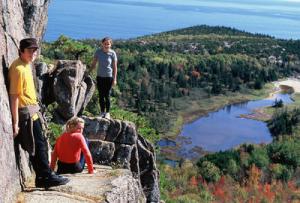
Acadia National Park is America's first national park east of the Mississippi.
Most of the park is located on Mount Desert Island, the third largest island on the East Coast, located mid way along the coast of Maine.
The park provides an amazing cornucopia of recreation with more than 100 miles of hiking trails, many of which were laid out by Native Americans, and 57 miles of the most unique system of stone carriage roads on the planet.
John D. Rockefeller Jr. had the foresight and wisdom way back in 1913 when the automobile was first invented to see it as a menacing threat.
He felt they would overcome our roads, threaten our peace and natural beauty and provide an easy means for lumber barons to penetrate the forest and strip it of all its trees.
So he spent 27 years designing an exquisite system of roads that crisscrossed his property on Mount Desert Island. "The Rockefeller Roads," as they were referred to, would serve as a refuge for hikers, horseback riders, the open horse-drawn carriages, and later, cyclists, but never an automobile.
Rockefeller "knew intimately the physical geography of Mount Desert Island.
Its hills, its shorelines, its streams, its woods, where the fine views are, where the autumn colors are best." He also had a passion for road building and a well-trained eye for beauty. Couple these talents and you have the best cycling roads I have ever experienced.
He designed the roads to wind past ponds, border marshes, wander through stands of spruce and beech, and skirt mountains until gently climbing for a panoramic view.
The construction of the Carriage Roads are state of the art, built to the highest standards and are said to be the finest example of broken stone roads in existence today. The final gravel layer is so fine that not once do we desire to be rolling along blacktop. We also aren't tempted to rip and tear down the descents because there is so much beauty to absorb.
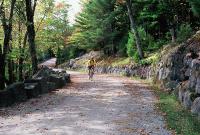
Besides the scenic qualities that the Carriage Roads offer, there are 16 stone bridges that span creeks and roadways, each with its own unique character and design.
They were created by a team of craftsmen, architects, masons and laborers, under the watchful eye of Rockefeller.
Made of native stone, they contain a wide variety of arches, cobblestones, even crenellated parapets and towers reminiscent of an English castle. Each one took about a year to complete and deserves a break from pedaling to explore. Many trailheads lead off from the Carriage Roads, coaxing us to the open bald summits of the island's mountains.
Acadia National Park offers the perfect opportunity to switch sports and stretch your legs, combining hiking and cycling on the same trip.
We decide to cycle the best of the Carriage Roads first.
We park at Eagle Lake for a 20-mile loop around the base of Sargent Mountain and Gilmore Peak, then circle back to skirt very scenic Jordon Pond. Gradually we climb the mountain's shoulders, which offer magnificent views of fiord Somes Sound.
The Sound has precipitous mountains on both sides and plunges down to the icy depth of 168 feet. We quickly learn that the climbs are so well graded that if you have to shift into your lowest gear, you don't stay there for very long. Just about the time you feel you've had enough, the road tops or levels out and spreads the most glorious vistas before you.
Although in the early days the Carriage Roads were considered a scar on the landscape, visitors are now exceedingly grateful to Rockefeller for his generosity and foresight.
Acadia's Carriage Roads are on the Historic Register of National Places and are truly a national treasure.
In all, more than 35,000 acres were given as a gift from Rockefeller, making it the only national park formed by private donations.

Acadia's topography is a direct result of thousands of years of sculpting by glacial ice.
The flowing ice carved absolutely everything we see, exposing the bald summits by scraping them down to the exposed bedrock.
When we become hungry, we pedal over to Jordon Pond Gate House Restaurant for the most memorable afternoon tea of our lives. There on the sloping lawn, with shimmering Jordon Pond and two small rounded peaks called "The Bubbles" to entertain us, we sit at picnic tables.
We sip tea, butter crispy hot popovers and slather on homemade raspberry preserves. "We're living large," my son Bryce murmurs.
Rockefeller strategically placed the French-Romanesque Gatehouse located at Jordon Pond (and also one at Brown Mountain) where auto roads and Carriage Roads connect. Their purpose was to monitor the entrances and keep automobiles off the Carriage Roads.
Here we meet two black velvety draft horses that stand poised and ready with their lacquered carriage, offering guests a real 1913 experience.
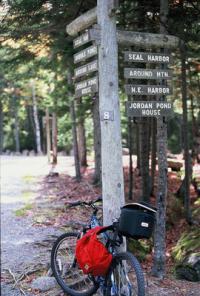
Getting around the vast network of interlacing Carriage Roads is simple; there are free Carriage Road User Maps available that show mileage in-between signposts.
At every intersection are elaborate signposts giving names of destinations for and aft. The maps also show where parking and restrooms are located.
One wonderful free addition to the park is the Island Explorer Shuttle Bus.
Driven by a grant from L.L. Bean, the bus runs to various locations in the local town of Bar Harbor to key parking lots in the park. Since you can take your bike on the bus, you are given many options for touring. It operates from about June 23 to Columbus Day weekend. The service is electric, so it is an environmentally conscious way to enjoy the park.
Our group of seven, however, was forced to use our own vehicles; the bus can only handle four bikes at a time.
Our second day is mostly spent on the 27-mile blacktop Park Loop Road.
There are so many sights to see -- Sand Beach, a rare stretch of pristine beach, Otter Cliffs, with their 100-foot pink granite buttresses jutting right out of the water and Thunder Hole blowhole, which really looks like a Yellowstone Geyser during tumultuous seas.
Our favorite is a very exposed climb up "The Beehive, whose 520-foot face is honeycombed by scouring glaciers.
A climber needs to solicit the aid of iron hand holds and ladders secured directly into the granite. It is not for the fainthearted, but we rank it as one of our favorite experiences in the park.
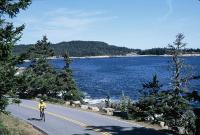
One blacktop cycle we were told to absolutely not miss, is a jaunt out to Scoodic Peninsula, a long granite finger of land that forms the eastern boundary of Frenchmen Bay.
Most tourists simply do not bother venturing out there, but the 2,000-acre tract is also a part of Acadia National Park, the only wedge of the mainland, which joined the park in 1929.
It is located about a one-hour car ride north of Mount Desert Island. The ride is a 15-mile loop that incorporates a very scenic 5-mile, one-way park drive that hugs the gorgeous coastline. On our third day of cycling, we find the peninsula road nearly deserted, even on a busy holiday weekend.
From our vantage point on Scoodic Peninsula, we have exceptional long-distance views across the bay to Cadillac and all the mountains of Mount Desert Island.
There are many cobble beaches to hop off your bike and take a walk over. Tumbling waves smoothed the glacial rocks and sound like tinkling glass as the surf jostles them.
Scoodic Point is spectacular as wave after relentless wave smashes into rocks, shooting plumes of ocean spray into the air. It's a perfect place for a picnic, stretching out on the sun-warmed granite amongst the diving gulls.
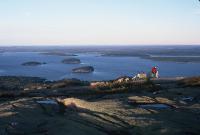
On our last morning at Acadia, we set the alarm and race to Cadillac's summit to assist the sun in its rising.
It is a tradition, a ritual, for from Oct. 7 to March 6, Cadillac Mountain is the first place to see the light of day in North America.
As we stand on the brow of the granite dome and watch a pool of molten color spread across the bay, we think about what Rockefeller once said.
"I hoped the land would one day become a real gem of the first order among national parks."
Judging from the heart-quickening beauty we are surveying around Cadillac's summit and the last few days of wondrous cycling, I would have to say Rockefeller's dream came true.
Maine Office of Tourism, 888-95-MAINE, or www.visitmaine.com.
(Cindy Ross is a travel writer who lives in Pennsylvania.)
You might also be interested in:
Exploring the Pacific Northwest
Norway's Ultimate Natural Thrill
Tutka Bay Lodge Luxury Alaskan Style
AFRICA TRAVEL | AMERICAS TRAVEL | EUROPE TRAVEL | 10 BEST in TRAVEL | FAMILY VACATIONS | AUTOS | HOBBIES | EDUCATION | FAMILY | FASHION | FOOD & RECIPES | HOME DECOR | RELATIONSHIPS | PARENTING | PETS | TRAVEL | WOMEN
Article: Copyright ©, Tribune Media Services Inc.
Vacation Travel | Cycling Maine's Acadia National Park - Cindy Ross World's Fare